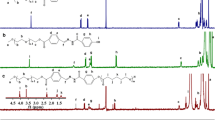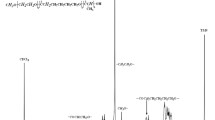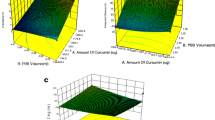Abstract
Purpose. Polymeric micelles were designed for targeting of a water-insoluble anticancer agent, camptothecin (CPT). Chemical structures of inner core segment were optimized to achieve high incorporation efficiency and stable CPT-loaded micelles.
Methods. Poly(ethylene glycol)-poly(β-benzyl L-aspartate) block copolymer (PEG-PBLA) was synthesized. The PBLA chain was modified by alkaline hydrolysis of its benzyl group followed by esterification with benzyl, n-butyl, and lauryl groups. Incorporation of CPT into micelles was carried out by an evaporation method. The stability of drug-loaded micelles was studied by gel-permeation chromatography (GPC), and their in vitro release behaviors were analyzed.
Results. CPT was incorporated into polymeric micelles constructed by various block copolymers. Among the esterified groups, block copolymers with high benzyl ester contents showed high CPT loading efficiency and stable CPT-loaded micelles. In chain lengths, 5-27 Bz-69 showed the highest incorporation efficiency. In contrast, 5-52 Bz-67, which had a longer hydrophobic chain, showed low incorporation efficiency. Release of CPT from the micelles was dependent on the benzyl contents and chain lengths. Sustained release was obtained when the benzyl content was high.
Conclusions. CPT was successfully incorporated into polymeric micelles with high efficiency and stability by optimizing chemical structures of the inner core segment.
Similar content being viewed by others
REFERENCES
R. P. Hertzberg, M. J. Caranfa, and S. M. Hecht. On the mechanism of topoisomerase I inhibition by camptothecin: evidence for binding to an enzyme-DNA complex. Biochemistry 28:4629–4638 (1989).
J. Fassberg and V. J. Stella. A kinetic and mechanistic study of the hydrolysis of camptothecin and some analogues. J. Pharm. Sci. 81:676–684 (1992).
X. Liu, B. C. Lynn, J. Zhang, L. Song, D. Bom, W. Du, D. P. Curran, and T. G. Burke. A versatile prodrug approach for lipo-somal core-loading of water-insoluble camptothecin anticancer drugs. J. Am. Chem. Soc. 124:7650–7661 (2002).
B. B. Lundberg. Biologically active camptothecin derivatives for incorporation into liposome bilayers and lipid emulsions. Anti-cancer Drug Des. 13:453–461 (1998).
D. S. Chow, L. Gong, M. D. Wolfe, and B. C. Giovanella. Modified lactone/carboxylate salt equilibria in vivo by liposomal delivery of 9-nitro-camptothecin. Ann. N. Y. Acad. Sci. 922:164–174 (2000).
W. Tong, L. Wang, and M. J. D'Souza. Evaluation of PLGA microspheres as delivery system for antitumor agent-camptothecin. Drug Dev. Ind. Pharm. 29:745–756 (2003).
V. Kumar, J. Kang, and R. J. Hohl. Improved dissolution and cytotoxicity of camptothecin incorporated into oxidized-cellulose microspheres prepared by spray drying. Pharm. Dev. Technol. 6:459–467 (2001).
B. Ertl, P. Platzer, M. Wirth, and F. Gabor. Poly(D,L-lactic-co-glycolic acid) microspheres for sustained delivery and stabilization of camptothecin. J. Control. Rel. 61:305–317 (1999).
J. W. Singer, P. De Vries, R. Bhatt, J. Tulinsky, P. Klein, C. Li, L. Milas, R. A. Lewis, and S. Wallace. Conjugation of campto-thecins to poly-(L-glutamic acid). Ann N Y Acad Sci 922:136–150 (2000).
C. D. Conover, R. B. Greenwald, A. Pendri, and K. L. Shum. Camptothecin delivery systems: the utility of amino acid spacers for the conjugation of camptothecin with polyethylene glycol to create prodrugs. Anticancer Drug Des. 14:499–506 (1999).
S. S. Dharap, B. Qiu, G. C. Williams, P. Sinko, S. Stein, and T. Minko. Molecular targeting of drug delivery systems to ovarian cancer by BH3 and LHRH peptides. J. Control. Rel. 91:61–73 (2003).
K. M. Tyner, S. R. Schiffman, and E. P. Giannelis. Nanobiohybrids as delivery vehicles for camptothecin. J. Control. Rel. 95: 501–514 (2004).
M. Yokoyama, T. Okano, Y. Sakurai, H. Ekimoto, C. Shibazaki, and K. Kataoka. Toxicity and antitumor activity against solid tumors of micelle-forming polymeric anticancer drug and its extremely long circulation in blood. Cancer Res. 51:3229–3236 (1991).
Y. Mizumura, Y. Matsumura, T. Hamaguchi, N. Nishiyama, K. Kataoka, T. Kawaguchi, W. J. Hrushesky, F. Moriyasu, and T. Kakizoe. Cisplatin-incorporated polymeric micelles eliminate nephrotoxicity, while maintaining antitumor activity. Jpn. J. Cancer Res. 92:328–336 (2001).
M. Yokoyama, T. Okano, Y. Sakurai, S. Fukushima, K. Oka-moto, and K. Kataoka. Selective delivery of adriamycin to a solid tumor using a polymeric micelle carrier system. J. Drug Target. 7:171–186 (1999).
M. Yokoyama, A. Satoh, Y. Sakurai, T. Okano, Y. Matsumura, T. Kakizoe, and K. Kataoka. Incorporation of water-insoluble anti-cancer drug into polymeric micelles and control of their particle size. J. Control. Rel. 55:219–229 (1998).
V. P. Torchilin, A. N. Lukyanov, Z. Gao, and B. Papahadjopoulos-Sternberg. Immunomicelles: targeted pharmaceutical carriers for poorly soluble drugs. Proc. Natl. Acad. Sci. USA 100:6039–6044 (2003).
V. P. Torchilin. PEG-based micelles as carriers of contrast agents for different imaging modalities. Adv. Drug Deliv. Rev. 54:235–272 (2002).
J. Liaw, S. F. Chang, and F. C. Hsiao. In vivo gene delivery into ocular tissues by eye drops of poly(ethylene oxide)-poly( propylene oxide)-poly(ethylene oxide) (PEO-PPO-PEO) polymeric micelles. Gene Ther. 8:999–1004 (2001).
S. V. Vinogradov, T. K. Bronich, and A. V. Kabanov. Self-assembly of polyamine-poly(ethylene glycol) copolymers with phosphorothioate oligonucleotides. Bioconjug. Chem. 9:805–812 (1998).
Y. G. Takei, T. Aoki, K. Sanui, N. Ogata, Y. Sakurai, and T. Okano. Temperature-modulated platelet and lymphocyte inter-actions with poly(N-isopropylacrylamide)-grafted surfaces. Bio-materials 16:667–673 (1995).
Y. Kaneko, S. Nakamura, K. Sakai, A. Kikuchi, T. Aoyagi, Y. Sakurai, and T. Okano. Synthesis and swelling-deswelling kinetics of poly(N-isopropylacrylamide) hydrogels grafted with LCST modulated polymers. J. Biomater. Sci. Polym. Ed. 10:1079–1091 (1999).
A. Harada and K. Kataoka. Pronounced activity of enzymes through the incorporation into the core of polyion complex mi-celles made from charged block copolymers. J. Control. Rel. 72: 85–91 (2001).
Z. Tuzar and P. Kratochvil. Block and graft copolymer micelles in solution. Adv. Colloid Interface Sci. 6:201–232 (1976).
K. Greish, J. Fang, T. Inutsuka, A. Nagamitsu, and H. Maeda. Macromolecular therapeutics: advantages and prospects with special emphasis on solid tumour targeting. Clin. Pharmacokinet. 42:1089–1105 (2003).
Y. Matsumura, M. Yokoyama, K. Kataoka, T. Okano, Y. Sakurai, T. Kawaguchi, and T. Kakizoe. Reduction of the side effects of an antitumor agent, KRN5500, by incorporation of the drug into polymeric micelles. Jpn. J. Cancer Res. 90:122–128 (1999).
M. Yokoyama, P. Opanasopit, Y. Maitani, K. Kawano, and T. Okano. Polymer design and incorporation method for polymeric micelle carrier system containing water-insoluble anti-cancer agent camptothecin. J. Drug Target. (in press).
M. Yokoyama, G. S. Kwon, T. Okano, Y. Sakurai, T. Seto, and K. Kataoka. Preparation of micelle-forming polymer-drug conjugates. Bioconjug. Chem. 3:295–301 (1992).
A. Lavasanifar, J. Samuel, and G. S. Kwon. Micelles self-assembled from poly(ethylene oxide)-block-poly(N-hexyl stea-rate L-aspartamide) by a solvent evaporation method: effect on the solubilization and haemolytic activity of amphotericin B. J Control. Rel. 77:155–160 (2001).
M. Yokoyama, G. S. Kwon, T. Okano, Y. Sakurai, and K. Kataoka. Influenceing factors on in vitro micelle stability of adriamycin-block copolymer conjugates. J. Control. Release 28: 59–65 (1994).
A. Shenderova, T. G. Burke, and S. P. Schwendeman. The acidic microclimate in poly(lactide-co-glycolide) microspheres stabilizes camptothecins. Pharm. Res. 16:241–248 (1999).
C. Zhao, Y. Wang, M. A. Winnik, G. Riess, and M. D. Croucher. Fluorescence probe technique used to study micelle formation in water-soluble block co-polymer. Langmuir 6:514–516 (1990).
M. Yokoyama, M. Miyauchi, N. Yamada, T. Okano, Y. Sakurai, K. Kataoka, and S. Inoue. Characterization and anticancer activity of the micelle-forming polymeric anticancer drug adriamycin-conjugated poly(ethylene glycol)-poly(aspartic acid) block co-polymer. Cancer Res. 50:1693–1700 (1990).
J. Fassberg and V. J. Stella. A kinetic and mechanistic study of the hydrolysis of camptothecin and some analogues. J. Pharm. Sci. 81:676–684 (1992).
Author information
Authors and Affiliations
Rights and permissions
About this article
Cite this article
Opanasopit, P., Yokoyama, M., Watanabe, M. et al. Block Copolymer Design for Camptothecin Incorporation into Polymeric Micelles for Passive Tumor Targeting. Pharm Res 21, 2001–2008 (2004). https://doi.org/10.1023/B:PHAM.0000048190.53439.eb
Issue Date:
DOI: https://doi.org/10.1023/B:PHAM.0000048190.53439.eb




